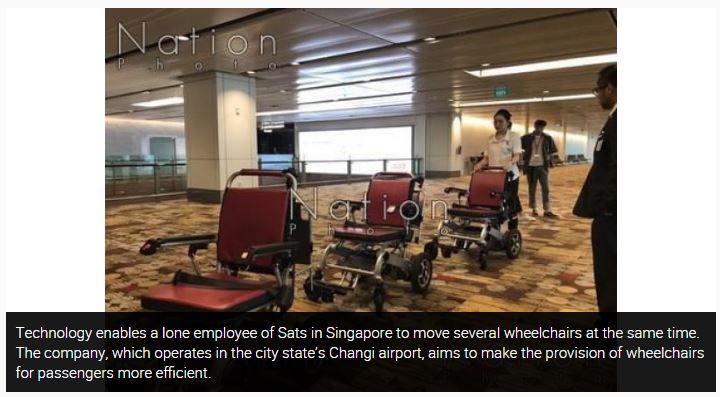Thailand: Digital makeover for traditional businesses gains ground
SMALL and medium-sized enterprises in Singapore are seizing on the opportunities presented by Internet of Things technology as part of efforts to digitalise traditional businesses ranging from airport gateway services to restaurants.
Among the companies making this leap is Sats Ltd, which uses a small cargo robot, known as an automated guided vehicle (AGV), that can follow company staff on their rounds supplying food to airlines lounges in Singapore’s Changi International Airport.
“It makes the job much easier and fun,” said Tan Yen Ling, manager public affairs and branding at Sats, which provides gateway services and food services in the airport.
Making use of so-called follow me technology from Japan, the AGV can recognise the legs of an operator when he or she walks and begins to follow automatically. The machine operator does not need to push or drag the robot, which is power by electricity.
Exploiting this concept, the company is testing new kinds of wheelchairs that can follow each other. One worker can control several wheelchairs at the same time. This innovation can save on costs and time when air passengers need wheelchairs to get on and off a plane.
Currently, only one worker can handle a wheelchair at the same time. The follow me technology will boost productivity, Tan said.
The company is also introducing virtual and augmented reality technology to help train new workers on aspects of ground control operations.
Wahid Spyke Allapitchay, who owns the Task Tish Tosh restaurant in the popular tourist district of Kampng Glam, said that he began digitalising his restaurant business three to four months ago.
“My restaurant is small and has only a few tables, so my task is to get more customers and serve customers their food faster ,” he said. Toolang dishes, based around bone marrow, are the most items on the menu at his food shop.
Under the old practice, the customers would come in and waiters take the orders, which ended up on two pieces of paper – one for the chef and the other for the front counter.
With the new system, customers can order electronically, resulting in a saving of seven minutes – a lot for a restaurant operator, Allapitchay said
When his staff are not busy they go on social media and act as brand ambassadors to promote the restaurant, he said.
Saeid Labbafi, chairman of One Kampong Gelam Association (OKG) and owner of a carpet shop, has also digitalised his business. He said it increased sales and customers can also buy online, swayed by the presentation of a story behind each unique piece of carpet.
He also plans to incorporate virtual and augmented reality technologies into his business as these capabilities would allow potential buyers to match carpets with the furnishings and furniture in their rooms before buying.
Allapitchay and Labbafi are the among shop owners who have participated in “Kampong Glam: Singapore’s First Digitally enabled Retail Neighbourhood”. The project is supported by the Infocomm Media Development Authority (IMDA), Enterprise Singapore (ESG), the Singapore Malay Chambers of Commerce and Industry (SMCCI), OKG and industry partners.
Kampong Glam is traditional neighbourhood rich in culture and heritage and is one of Singapore’s major tourist hot spots.
There are about 600 shops in Kampong Glam; so far, 180 have joined the project, which started in November last year, according to the SMCCI.
The digitalisation project promotes cashless payment and enhances merchants’ presence on Google Maps to improve their discoverability. To service visitor betters, a self-guided story-telling and discovery experiential mobile app is also available. An app for integrated logistics solutions is also available for merchants. Moreover, integrated point-of-sales system will enable merchants to manage accounting, customer relations management and inventory management in a seamless and co-ordinated way the SMCCI said.
Source: http://www.nationmultimedia.com/detail/Corporate/30357188


 Thailand
Thailand




